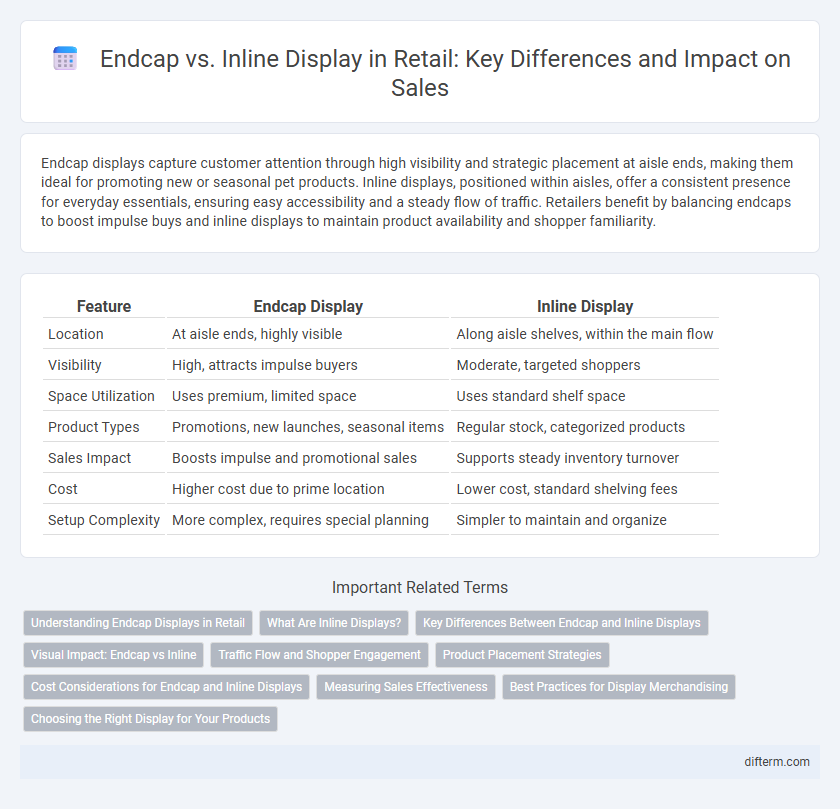Endcap displays capture customer attention through high visibility and strategic placement at aisle ends, making them ideal for promoting new or seasonal pet products. Inline displays, positioned within aisles, offer a consistent presence for everyday essentials, ensuring easy accessibility and a steady flow of traffic. Retailers benefit by balancing endcaps to boost impulse buys and inline displays to maintain product availability and shopper familiarity.
Table of Comparison
| Feature | Endcap Display | Inline Display |
|---|---|---|
| Location | At aisle ends, highly visible | Along aisle shelves, within the main flow |
| Visibility | High, attracts impulse buyers | Moderate, targeted shoppers |
| Space Utilization | Uses premium, limited space | Uses standard shelf space |
| Product Types | Promotions, new launches, seasonal items | Regular stock, categorized products |
| Sales Impact | Boosts impulse and promotional sales | Supports steady inventory turnover |
| Cost | Higher cost due to prime location | Lower cost, standard shelving fees |
| Setup Complexity | More complex, requires special planning | Simpler to maintain and organize |
Understanding Endcap Displays in Retail
Endcap displays in retail are strategically positioned at the ends of aisles to maximize product visibility and boost impulse purchases. These displays leverage high foot traffic areas, creating prominent real estate for promotions, seasonal items, or new product launches. Compared to inline displays, endcaps offer superior customer engagement by standing out in the store layout, directly influencing buying decisions.
What Are Inline Displays?
Inline displays are retail fixtures positioned along the main aisles within store shelves, allowing products to be showcased at eye level to maximize customer visibility and engagement. These displays are designed to fit seamlessly between shelving units, optimizing floor space while promoting continuous product exposure throughout the shopping path. By maintaining a streamlined appearance, inline displays help retailers effectively organize merchandise and drive incremental sales through strategic product placement.
Key Differences Between Endcap and Inline Displays
Endcap displays are positioned at the end of aisles to maximize visibility and impulse buying, while inline displays are placed along the store aisles, integrating directly with product shelves. Endcaps typically showcase promotional or seasonal items and draw foot traffic from multiple directions, whereas inline displays maintain a consistent shopping flow by complementing adjacent products. The strategic placement of endcaps often results in higher sales lift, while inline displays provide steady product exposure within the regular shopping path.
Visual Impact: Endcap vs Inline
Endcap displays generate higher visual impact by positioning products at aisle intersections, capturing shopper attention with 50% more foot traffic compared to inline displays. Inline displays, located along the main aisle, offer consistent brand visibility but typically achieve lower engagement rates, around 20-30% less than endcaps. Effective retail strategies leverage endcap placements to maximize impulse purchases and overall sales performance.
Traffic Flow and Shopper Engagement
Endcap displays capture higher traffic flow by positioning products at key aisle intersections, enhancing visibility and impulse purchases. Inline displays maintain consistent shopper engagement by providing organized, accessible product placements along aisles, supporting routine browsing habits. Retailers optimize shelf space efficiency through a strategic balance of endcaps for promotional impact and inline displays for steady product exposure.
Product Placement Strategies
Endcap displays maximize product visibility by positioning merchandise at the end of aisles, capturing high traffic and impulse purchases, while inline displays integrate products within the main shelving to maintain consistent brand presence and cater to routine shoppers. Effective product placement balances eye-level positioning and accessibility, leveraging shopper behavior data to strategically allocate prizing and promotions. Optimizing endcap and inline displays increases sales velocity and enhances customer experience through targeted product exposure.
Cost Considerations for Endcap and Inline Displays
Endcap displays typically incur higher costs due to prime placement fees and custom design requirements, impacting overall retail budgets more than inline displays. Inline displays offer a cost-effective solution by utilizing existing shelf space with minimal additional investment, making them suitable for retailers aiming to maximize product visibility without substantial expense. Evaluating budget constraints against promotional goals is crucial when choosing between endcap and inline display options in retail environments.
Measuring Sales Effectiveness
Endcap displays typically generate up to 30% higher sales lift compared to inline displays due to their enhanced visibility and prime placement at aisle ends. Retailers measure sales effectiveness by analyzing incremental sales data, foot traffic patterns, and conversion rates associated with each display type. Implementing POS data analytics and A/B testing allows precise evaluation of which display maximizes revenue and customer engagement within specific store layouts.
Best Practices for Display Merchandising
Endcap displays maximize product visibility by positioning items at the aisle end, capturing high foot traffic and encouraging impulse purchases. Inline displays, located along the store aisles, support brand consistency and product adjacency strategies, facilitating cross-selling opportunities. Optimal merchandising integrates both by placing high-demand or promotional products on endcaps while using inline displays for complementary items, enhancing shopper navigation and engagement.
Choosing the Right Display for Your Products
Selecting the ideal retail display hinges on product type and store layout, where endcap displays maximize visibility by positioning products at aisle ends, boosting impulse purchases and highlighting promotional items. Inline displays fit within standard shelf rows, offering consistent exposure for everyday products and facilitating easy restocking. Balancing traffic flow and product accessibility guides retailers in choosing between high-impact endcaps or space-efficient inline displays to optimize sales performance.
Endcap vs Inline Display Infographic

 difterm.com
difterm.com